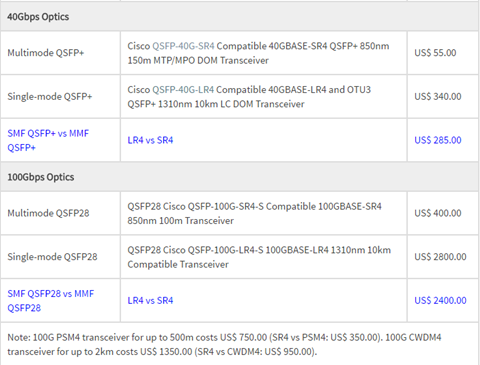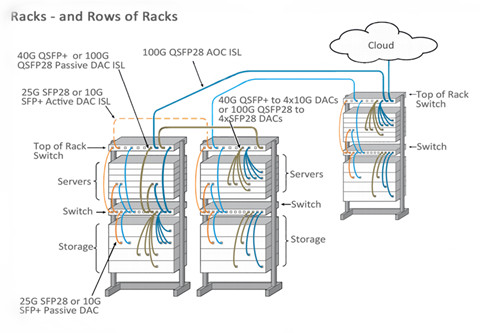March 31, 2017
10G SFP+ optical transceiver is considered as the mainstream form factor of the 2017 market due to its matured technology and lower price, even although 40G/100G optical modules are on the very top trend for enterprise and data center for the interconnection. 10G SFP+ modules come in several standards: SFP-10G-SR, SFP-10G-LR, 10GBASE-ER SFP+, and 10GBASE-LRM SFP+. This article will offer details about the difference between SFP-10G-SR and SFP-10G-LR.

Cisco SFP-10G-SR
SFP-10G-SR is compliant with 10GBASE-SR standard. The Cisco 10GBASE-SR module supports a link length of 26m on standard Fiber Distributed Data Interface (FDDI)-grade multimode fiber, up to 300m link lengths over OM3 and 400m link lengths over OM4 cables.
Cisco SFP-10G-SR transceiver is hot-swappable input/output device which allows a 10 Gigabit Ethernet port to link with a fiber optic network. Because it is hot-swappable and MSA compliant, the Cisco SFP-10G-SR transceiver can be plugged directly into any Cisco SFP+ based transceiver port, without the need to power down the host network system. This capability makes moves, add-ons and exchanges quick and painless. The data sheet of SFP-10G-SR is as follows:

The Cisco SFP-10G-SR series consists of two other modules: the Cisco SFP-10G-SR-S Module and the Cisco SFP-10G-SR-X Module.
The Cisco SFP-10G-SR-S module belongs to the Cisco S-class optics that possess the same performance with Cisco SFP-10G-SR module. For the detailed information about the difference between Cisco S-class and non S-class optics, you can review the previous article.
Cisco SFP-10G-LR
The Cisco 10GBASE-LR module supports a link length of 10 km on standard single-mode fiber. Compliant with 10GBase-LR standard, SFP-10G-LR can support up to 10km over single-mode fiber and uses 1310nm lasers. There is no minimum distance for LR, either, therefore it is suitable for short connections over single mode fiber, too. The following image shows a Cisco Compatible SFP-10G-LR SFP+.

10GBASE-LRM SFP+
10GBASE-LRM is the type of transceiver that customers may easily feel confused with 10GBASE-LR SFP+ optics. However, in short, 10GBASE-LRM SFP+ still uses the 1310nm lasers, but it can only reach up to 220 m over standard multimode fibers (OM3/OM4). The 10GBASE-LRM can be packaged in XFP and SFP+ form factors.
Besides the Cisco SFP-10G-LRM, there are a new type of the 10G SFP+ module for multimode fibers—SFP-10G-LRM2. It is a type of SFP+ transceivers compatible with the 10GBASE-LRM standard. SFP-10G-LRM2 can reach up to 2km over standard multimode fiber.
Do You Need Cisco Original Brand or Compatible SFP+ Modules?
If you spend a large sum of money on the Cisco original brand switch, next you may think of buying the compatible optics. However, there comes the problem, do I need the Cisco original brand modules?
To tell the truth, not every SFP+ modules can work well on the Cisco switch SFP+ ports. You must make sure of the compatibility before plugging the SFP+ transceivers on it. Furthermore, SFP+ modules are the essential components of fiber optic network, usually, network installers need a bunch of them for your network deployment. Thus, select cost-effective 3rd party modules are necessary. You can also purchase more for back up.
FS.COM, as a reliable and qualified fiber optics supplier, supplies a full range of optical transceivers with a large quantity of products available in stock. Our compatible Cisco SFP-10G-SR and SFP-10G-LR modules are provided at really low price. Cisco SFP-10G-SR is $16, and SFP-10G-LR is $34.
Conclusion
SFP-10G-SR is mainly used for short-reach 10G application, while SFP-10G-LR, with a link length of 10 km is ideal for metro infrastructure. Customers can choose either reliable SFP-10G-SR or SFP-10G-LR, according to their own needs.
Posted by: fernxu123 at
09:25 AM
| No Comments
| Add Comment
Post contains 593 words, total size 5 kb.
March 22, 2017
There is the long-term debate between single-mode and multimode optics. From the data rate, link distance, and costs, people usually will calculate every single difference between them. However, this article will not talk about the technical distinctions because you can find the related information everywhere. Cost, as one of the important factors, is sometimes the deciding point by many data center operators.
The cost difference between single-mode and multimode optics (optical transceiver modules and fiber optic cables) are quite obvious. Single-mode optics with longer transmission distance and more bandwidth, usually charges higher than multimode optics. The following part will take FS.COM’s Cisco compatible single-mode and multimode optics as an example, and make a vivid comparison between these optics from 1Gbps to 100Gbps.
SMF Vs. MMF Modules
In order to cope with the ever-lasting requirement for higher data rate and reliable fiber performance, telecommunication industry launches a whole series of devices. Fiber optic transceivers, as a representative, developed from the old 1Gbps SFP module, 10G SFP+ (SFP plus), 40G QSFP+, to the 100G QSFP modules. The price gap of the single-mode and multimode optics in these form factors are huge but fluctuating.
- Cisco Multimode SFP Vs. Single-mode SFP

Seen from the above table, the price difference between multimode and single-mode SFP is minor.
- Cisco Multimode SFP+ Vs. Single-mode SFP+
SFP-10G-SR and SFP-10G-LR are the Cisco 10G SFP+ transceiver modules that can be operate over multimode and single-mode fibers, respectively. Cisco SFP-10G-SR price is only US$ 16.00 from FS.COM. And SFP-10G-LR price is US$ 34.00. The price gap between them is US$ 18.00. Different vendors may offer this products at different prices, but believe in me, FS.COM has the lowest price for optical modules.
- Cisco 40Gbps & 100gbps single-mode Vs. Multimode Modules

Keep in mind, the number listed above is only the price of specified optical module. For the budget of a whole network, you should also count the other essential components and the maintenance cost.
Single-mode Vs. Multimode Fibers
It is known to all that whether to use single-mode or multimode fibers depends on the fiber optic transceiver types. In this case, the cost difference between single-mode and multimode fibers also depends on what optics you use. For example, SFP-10G-LRM Cisco can only work with LC single-mode fibers, while Cisco QSFP-40G-SR4 needs to be connected with MTP OM3/OM4 multimode fibers. Obviously MTP multimode fibers charges higher than LC single-mode fibers.
Conclusion
This article has listed the price gap between single-mode and multimode optics. Single-mode optics averagely charges higher than multimode optics. Whether you go for the single-mode or multimode cabling are all feasible. Keep in mind that single-mode cabling is for long-hual and multimode is for short-reach applications. And a reliable fiber optic transceiver module manufacturer like FS.COM will save you a large sum of money.
Posted by: fernxu123 at
03:18 AM
| No Comments
| Add Comment
Post contains 473 words, total size 4 kb.
March 15, 2017
Top of rack switching as the basic data center architecture, requires one or two access switch installed on the top pf each sever rack, which provides easy cable management and maintenance. Additionally, it reduce the cable requirement as all sever connections are terminated to its own rack. Direct attach cables (DAC) twinax cable can achieve interconnection up to 15 m at 10 Gbps or 40 Gbps with low power. Most server gears come default with DAC twinax cables in-rack along with a couple of short-throw lasers back to core. This article will present the cabling solutions of the DAC cables for data center top of rack deployment.
Why Use DAC Twinax Instead of Cat5e or Cat6 Cables for Top of Rack Switching?
What media option would be the best to invest in for top of rack application? Category copper cable (Cat5e or Cat6) used to be the preferable options. Cat5e or Cat6 cables, standardized on 10GBASE-T, are overall cheap, backward compatible and much easier for cable management, especially for shorter cable runs. But these days, DAC twinax cables are more suitable for top of rack switching owing to the following reasons.
First, most of the hosts we are buying are not with RJ45 on board and all the switches and firewalls we’ve used for years were SFP+. Second, the extra power consumption for 10GBASE-T is higher than DAC cables. Additionally, DAC cables has lower latency hit. Last but not least, people often prefer DAC twinax owing to its flexibility. People can easy swap a DAC cable for a SFP+ transceiver and generally connect to anything I need to.
Note that the decision between Cat5e/Cat6 cables and DAC comes down to what your strategy for server hardware is, if you don't run high density servers, or you use blade enclosures to reduce your server port count, Cat5e or Cat6 cables might be fine and should be much cheaper.
DAC Twinax Cables
For interconnection in top of racks, the direct attach cable assemblies are used to connect server to switch, storage to switch or switch to switch. Just as the following image shows, DAC twinax cables, available in direct attach passive or active copper cable, active optical cable or breakout direct attach cable assemblies, can cope with different interconnection applications.

Copper twinax cable with various length options, are popular on the market. For example, 10G SFP+ DACs are commonly used in interconnect application below 15 m, e.g. server to switch or storage to switch interconnection in the same rack. SFP-H10GB-CU2M is the 10G SFP+ passive direct attach copper cable used for short-reach direct connection. And for 40GbE, 40G QSFP+ DACs and AOCs are used, the former is usually used for short-interconnection below 15 m while the latter is used for longer interconnect application that over 15 m but less than 100 m. Of course, higher speed and more bandwidth are needed for spine switches. 100G DACs, like QSFP28 DACs are used in this case.
DAC Twinax Used in Top of Rack Switching
FS.COM offers a comprehensive solution for data center ToR deployment including cables, transceiver optics and direct attach cabling products to satisfy various demands on data rate. Depending on different layers, we offer the different solutions:
- Use Case for Interconnecting Rack Servers and ToR Switch
For interconnection between rack servers and ToR switch within rack, the Category 6a (Cat 6a) Ethernet patch cables or SFP+ direct attach cables can be used. The cable length depends on the distance from the rack server to the ToR switch that is limited to the vertical height of the cabinet.
- ToR Switch to Network Switch
When connecting the ToR switch to network switch, it requires increased transmission speeds and distances. For distances below 15 m, the SFP+ direct attach cable is still an ideal option. But if the distances are more than 15 m, we recommend you to use the multimode fiber with the corresponding optics. In addition, for distances less than 100 m, the SFP+ AOC (active optical cable) is a viable option.
- Network to Core Switch
At the core of data center, direct attach cables designed with QSFP+ connectors can be used for short distance transmission of up to 15 m to support up to 40Gbps. To support distances above 15 m, the OM3 or OM4 fiber is recommended to use with the QSFP+ optics. In addition, for distances less than 100 m, the QSFP+ AOC is a viable option.
Conclusion
Twinax copper cables including the DAC and AOC cables are the mainly used cable type to support high transfer rates between servers, switches and storage devices intra rack or inter rack in a data center. This article has concluded the reasons why we should DAC cables and the cabling solution for top pf rack switching.
Posted by: fernxu123 at
01:45 AM
| No Comments
| Add Comment
Post contains 800 words, total size 6 kb.
32 queries taking 0.0956 seconds, 80 records returned.
Powered by Minx 1.1.6c-pink.









